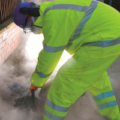BOHS welcomes new HSE guidance as Society wins European recognition for its Welding Fume Control Selector Tool
The British Occupational Hygiene Society (BOHS) has applauded the publication of new guidance from the Health and Safety Executive (HSE) on the effective management of exposures to welding fume.
In 2018 The International Agency for Research on Cancer (IARC) published a report with the reclassification of welding fume as carcinogenic to humans. Up until then it was previously thought that the risk of lung cancer was linked to welding stainless steels, as opposed to the much more commonly used mild steel.
This prompted HSE to request a review of evidence by the Workplace Health Expert Committee in 2019. The committee agreed with IARC and concluded that ‘welding fumes cause lung cancer and possibly kidney cancer, and that it is not possible to identify specific welding processes or base metals that give rise to this risk. UV exposure from arc welding processes causes melanoma in the eye and may also increase the risk of skin cancer’.
In 2019 HSE issued the Safety Alert: Change in Enforcement Expectations for Mild Steel Welding Fumes. This alert was intended to highlight the change to the classification of welding fume from a possible to a definite human carcinogen to industry.
Now, in November 2019, the HSE has published its revised COSHH Essentials guidance on controlling welding fume and has put great effort into ensuring that the new WL3 Control of Welding Fume sheet clarifies the different control options and their combinations suitable for common welding tasks. The HSE has also produced a new welding microsite containing its revised guidance on how to protect workers from welding fume.
In an effort to provide simple guidance on welding fume control for common welding tasks, BOHS launched the Welding Fume Control Selector Tool. The tool forms part of BOHS’ Breathe Freely in Manufacturing campaign, which aims to raise awareness of occupational lung disease caused by welding fumes in the manufacturing industry. A panel of experts from industry, consultancies, academia and the HSE formed a working group to create this tool in order to inform managers and supervisors of welders about the best welding fume controls available to protect their health.
The updating of the HSE’s online guidance has coincided with recognition by EU-OSHA of the Welding Fume Control Selector Tool. The official commendation was made at the Healthy Workplaces Good Practice Awards during the recent Health Workplaces Summit, held in Bilbao, Spain.
The Summit was the formal conclusion of EU-OSHA’s 2018/19 Dangerous Substances campaign and the final ceremony saw 10 organisations, including BOHS, awarded and commended for innovative approaches to managing dangerous substances.
The Agency chose to commend BOHS’ free web-based tool because it “addresses a real need in the manufacturing sector” and “the tool enables workers themselves to be involved in selecting the most appropriate control measures for welding fumes; such worker participation is key to successful prevention.” They’ve added that although the tool has been launched only recently, it has already received “considerable interest” and that active promotion and support for the tool is likely to lead to further significant uptake.
Commenting on these developments, John Dobbie, President of BOHS, said
BOHS greatly welcomes the important new guidance from the Health and Safety Executive and we are delighted to receive official commendation in the Healthy Workplaces Good Practice Awards from the European Agency for Safety and Health at Work. In time to come, I am certain that we, as occupational hygienists, will look back on 2019 as the year in which collective efforts against life-threatening lung disease caused by exposures to welding fume truly started to gain traction in the UK. At this critical stage, the Chartered Society for Worker Health Protection is urging employers to get their welding risks under control. Help in this regard is available from a wide range of excellent sources – from our free online Welding Control Selector Tool and other Breathe Freely resources to the HSE’s new web-based guidance and of course the simple yet practical and cost-effective advice available from professional occupational hygienists.

